
Table of Contents
Standing desks aren’t just a passing trend—they’re a shift in how we think about working. In a world where flexibility, health, and productivity all compete for attention, the standing desk offers a compelling solution. But while the benefits are clear, the drawbacks are worth understanding too.
In this guide, we’ll share practical tips to maximize comfort and unpack the real standing desk benefits and risks so you can make an informed decision.
Pros Of Standing Desks
1. Keeps You Active
One of the biggest advantages in the ongoing conversation around the pros and cons of a stand-up desk is how effectively they support active work. By simply standing while working, you engage your leg muscles, stimulate blood flow, and improve oxygen circulation. This steady movement throughout the day can help reduce the feeling of fatigue and boost alertness.
Pair this with a few light standing desk exercises throughout your day, and you’ll start to feel the difference.
2. Encourages Postural Changes
With traditional desks, it’s easy to stay locked into one posture, usually slouched, for hours. But one of the clear standing desk benefits and risks is learning to switch positions consciously. This keeps your muscles engaged and prevents stiffness in areas like your lower back, hips, and shoulders. A sit-stand desk makes it easy to shift positions without breaking your focus.
You can read more in our guide on how often you should stand up from your desk.
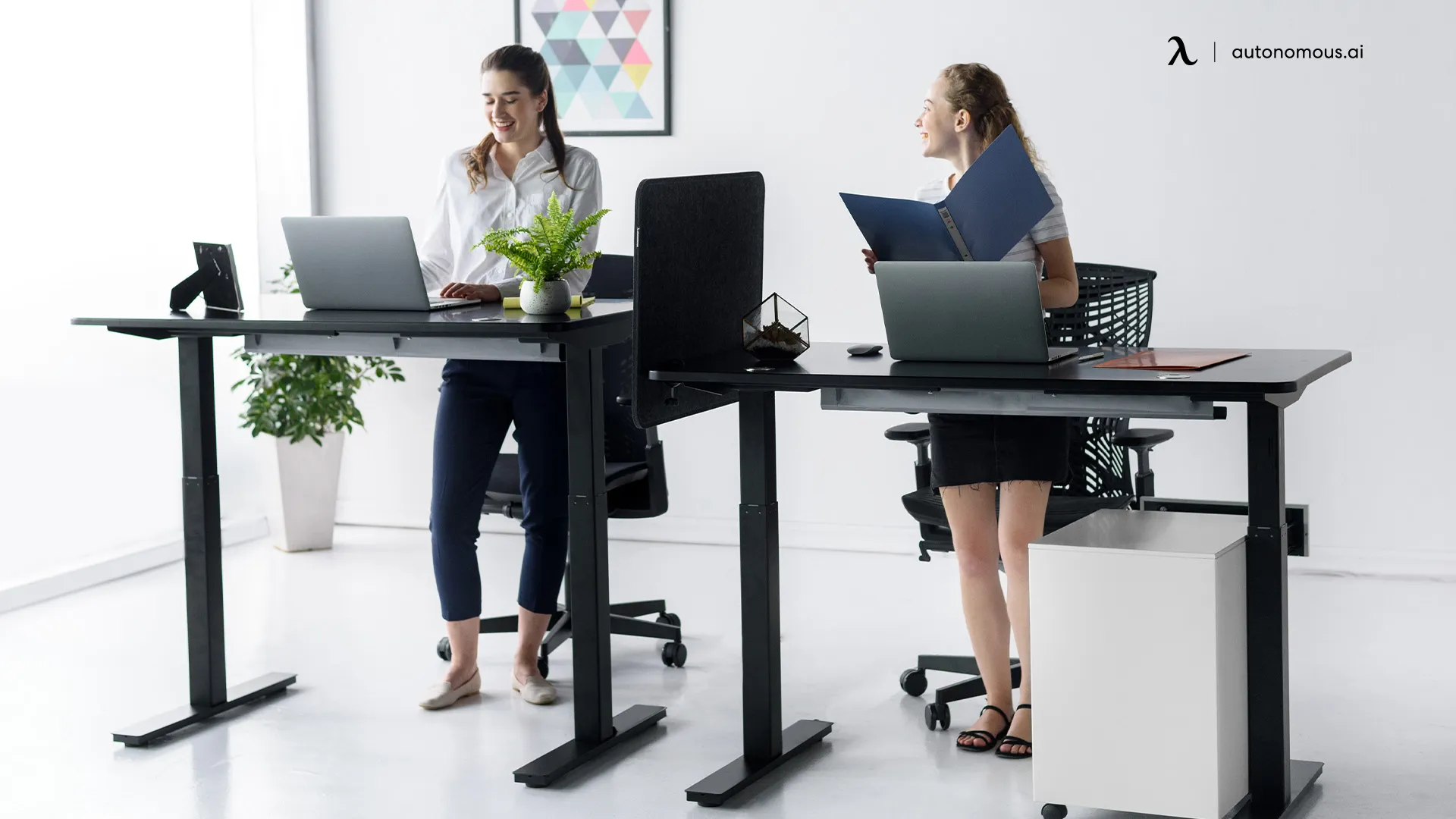
3. Burns Calories
People facing overweight issues are highly recommended to spend more time working while standing. According to the Journal of Physical Activity and Health, people who worked while standing burned more calories than people who worked while sitting.
When comparing the pros and cons of a standing desk, this benefit stands out for people looking to balance their workday with a more active lifestyle, even without hitting the gym.
When comparing the pros and cons of a standing desk, one clear benefit is its ability to support light activity throughout the day. In fact, using a standing desk for weight loss can help increase daily calorie burn in a low-impact, sustainable way—especially for those with sedentary jobs.
4. Personalized Height Settings
One of the standing desk pros is that you can change your presets for standing desk height. This takes the guesswork out of daily adjustments and ensures consistent ergonomics every time you switch modes. It’s also one of the subtle but impactful benefits that often gets overlooked in debates about the pros and cons of a standing desk.
If you get a standing desk with the preset feature, make sure to find the ideal desk height that matches the monitor and your eye level, and save the settings.
5. Diverse Styles For Any Space
Whether you're outfitting a compact apartment or building a productivity-packed home office, standing desks come in all shapes and sizes: L-shaped standing desks for corner offices, minimalist frames for small rooms. Some designs, like the luxury standing desk, focus on premium materials and executive aesthetics, while others cater to affordability, like the best budget standing desk.
You can even explore options tailored to specific needs, such as a standing desk for short people. However, when you search the market, make sure you check standing desk ergonomics before selecting one for your office.
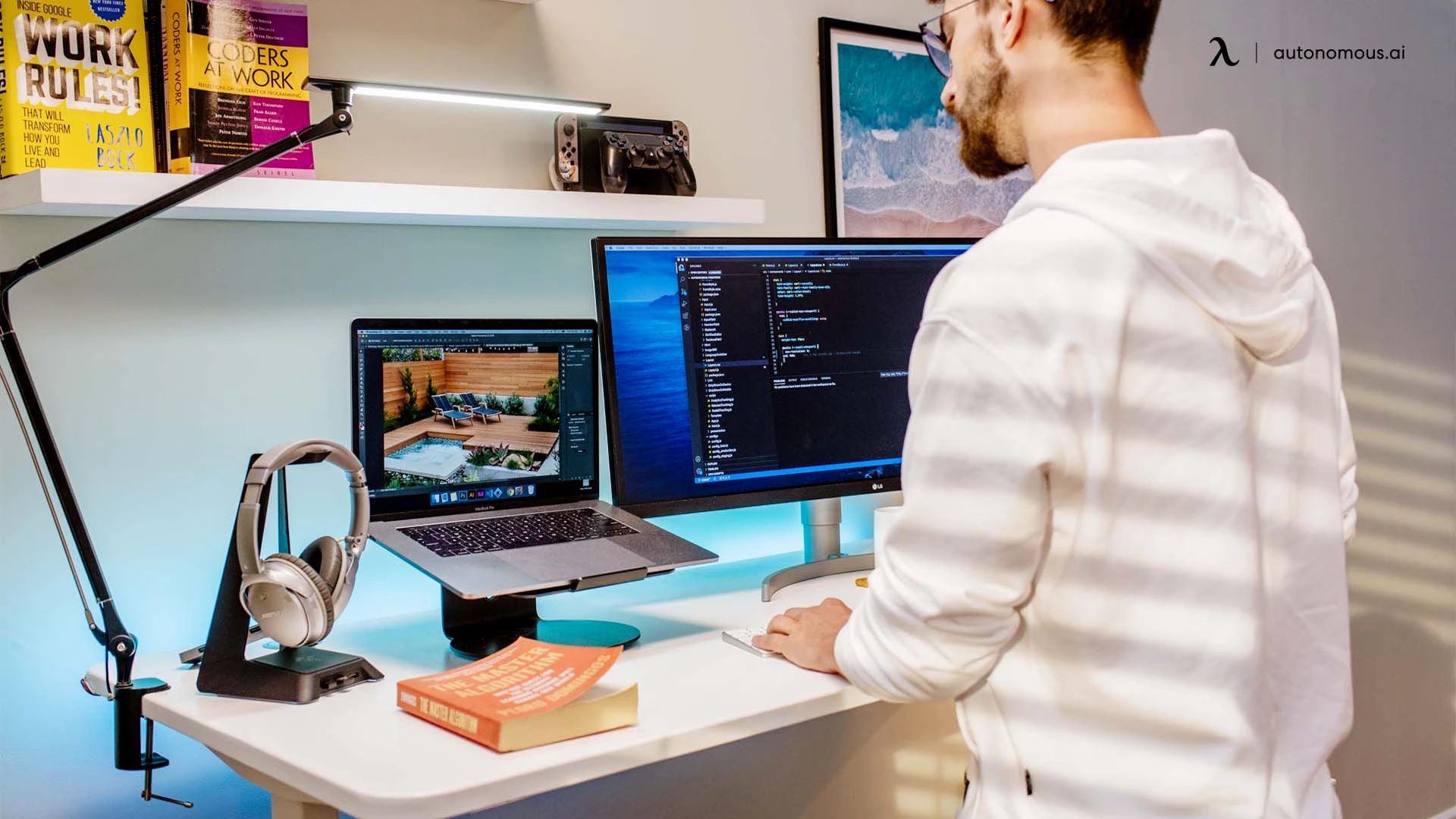
6. Better Circulation And Spinal Health
For people evaluating the pros and cons of a standing desk, spinal alignment is a major plus.
When you constantly change your position, blood flows throughout your body to increase energy levels and make you feel fresh. On the other hand, your spinal structure is also affected by the position you choose to work in. Standing upright naturally promotes a straighter spine, which helps prevent chronic issues like herniated discs or muscular imbalances.
7. Eases Chronic Back Pain
For people who suffer from lower back discomfort, standing desks can provide real relief. Standing for part of the day helps reduce the pressure that builds up in your lumbar spine from extended sitting, and it’s especially helpful when paired with ergonomic seating.
It’s a major consideration when weighing the pros and cons of a sit-stand desk, especially for those dealing with long-standing pain issues. Learn more in our article on a standing desk for lower back pain.
Cons of Standing Desks
Understanding the disadvantages of standing desk setups is just as important as celebrating their benefits. Let’s take a closer look at the common drawbacks users face.
1. Higher Upfront Cost
Compared to a basic desk, standing desks—especially motorized ones—are more expensive. The price comes from the motors, steel frames, and programmable controls. While this is one of the more obvious disadvantages of standing desk options, many users find the long-term health benefits worth the price.
If you're considering a more traditional route, you might look at a non electric standing desk or even a non adjustable standing desk as a more affordable alternative.
2. Lack Of Built-In Storage
Most standing desks you will find in the market are manufactured with a primary focus on versatility and ergonomics rather than storage space. Limited storage is a practical drawback in the pros and cons of a stand up desk conversation, especially for those used to traditional executive desks with ample compartments. You’ll likely need to invest in separate under-desk storage or mobile pedestals.
3. Sore Feet And Varicose Veins
When you stand for a lot longer than your legs can hold, you might start noticing swelling on the surface of your skin. This is known as varicose veins, which happen due to the lack of blood reaching back up from the upper part. This is one of the most common disadvantages of standing desk setups, though it’s often preventable with accessories like anti-fatigue mats and supportive shoes.
For those also concerned about circulation, here’s a guide on how to prevent feet from swelling while sitting at a desk.
4. Not Ideal For Older Office Workers
While the pros and cons of a standing desk vary depending on age and physical condition, one recurring challenge is that older adults or those with joint issues may find it uncomfortable to stand for extended periods. Still, shorter intervals can offer benefits without overwhelming the body.
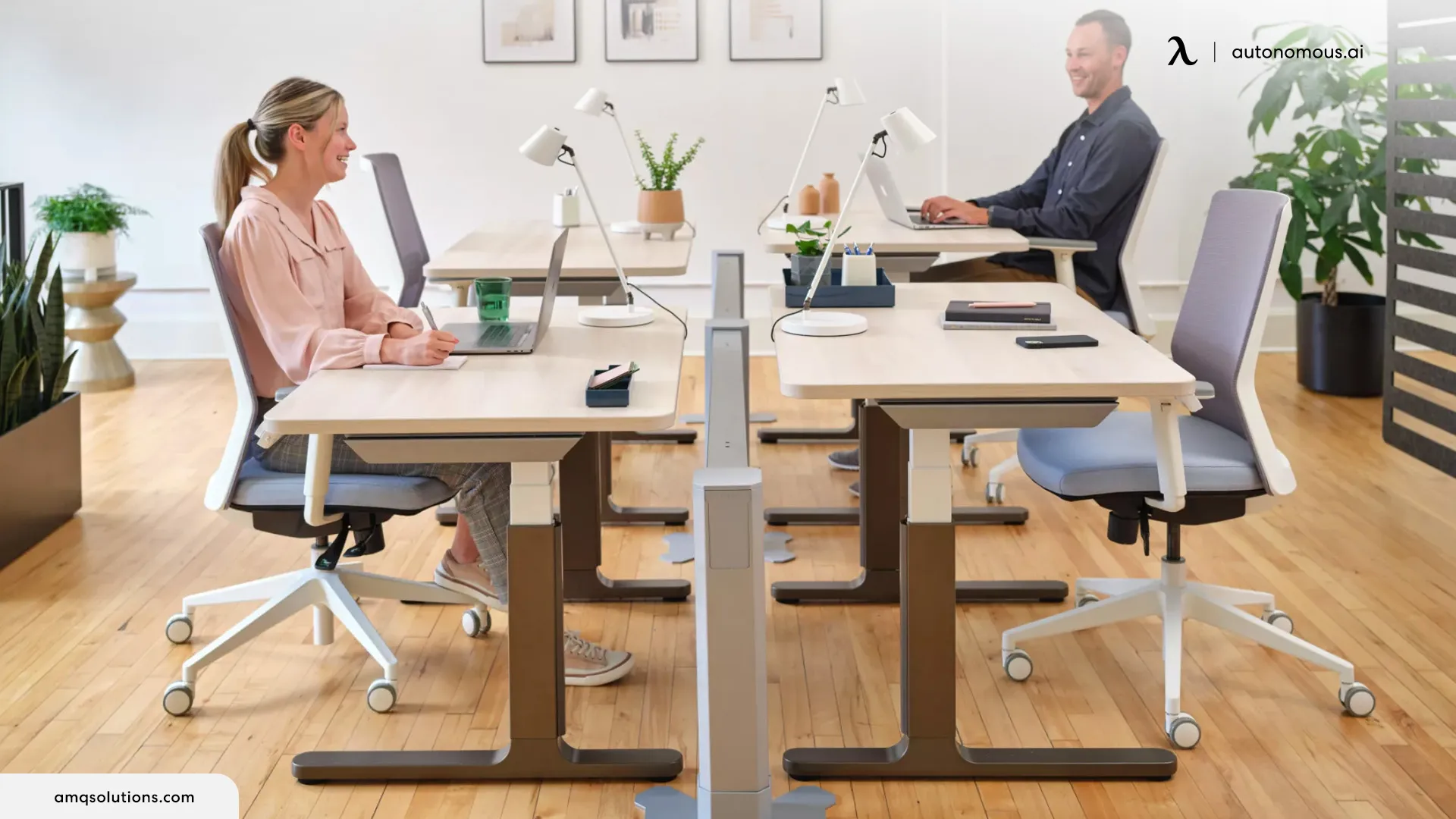
How To Set Up A Standing Desk The Right Way
A big part of understanding the pros and cons of a standing desk lies in how well the desk is set up. Even the best desk can cause discomfort if not adjusted properly. Here's a complete standing desk setup guide on how to use a standing desk and make the most of it from the start.
Here’s how to do it right:
1. Dial In Your Desk Height
Getting the desk height right is the foundation of an ergonomic setup. When standing, your elbows should be bent at 90 degrees, and your forearms should rest naturally on the desk surface. This allows you to type and use your mouse without straining your shoulders or wrists. If the desk stops working mid-adjustment, here’s a fix for a standing desk not going up.
An electric desk with height memory presets can save your ideal position, so you're not manually readjusting it every time. If your desk isn’t responding, here’s how to reset your standing desk or unlock your standing desk if needed.
2. Align Your Monitor
Your screen needs to be positioned at or just slightly below eye level. This prevents the tendency to crane your neck forward or tilt your head down, which can lead to neck and upper back strain over time. You can use a monitor riser or an adjustable monitor arm if needed.
3. Get An Anti-Fatigue Mat
Standing on hardwood or tile for long hours can quickly wear on your legs, ankles, and lower back. To combat one of the most common disadvantages of standing desk use—sore feet and fatigue—place an anti-fatigue mat under your workspace. An anti-fatigue mat provides a cushioned surface that encourages subtle movements in your leg muscles, keeping circulation active and reducing the onset of fatigue. It makes standing feel less like a chore and more like a natural part of your workflow.
Fitness enthusiasts can go one step ahead and choose a standing desk treadmill, allowing them to run while working on their laptop.
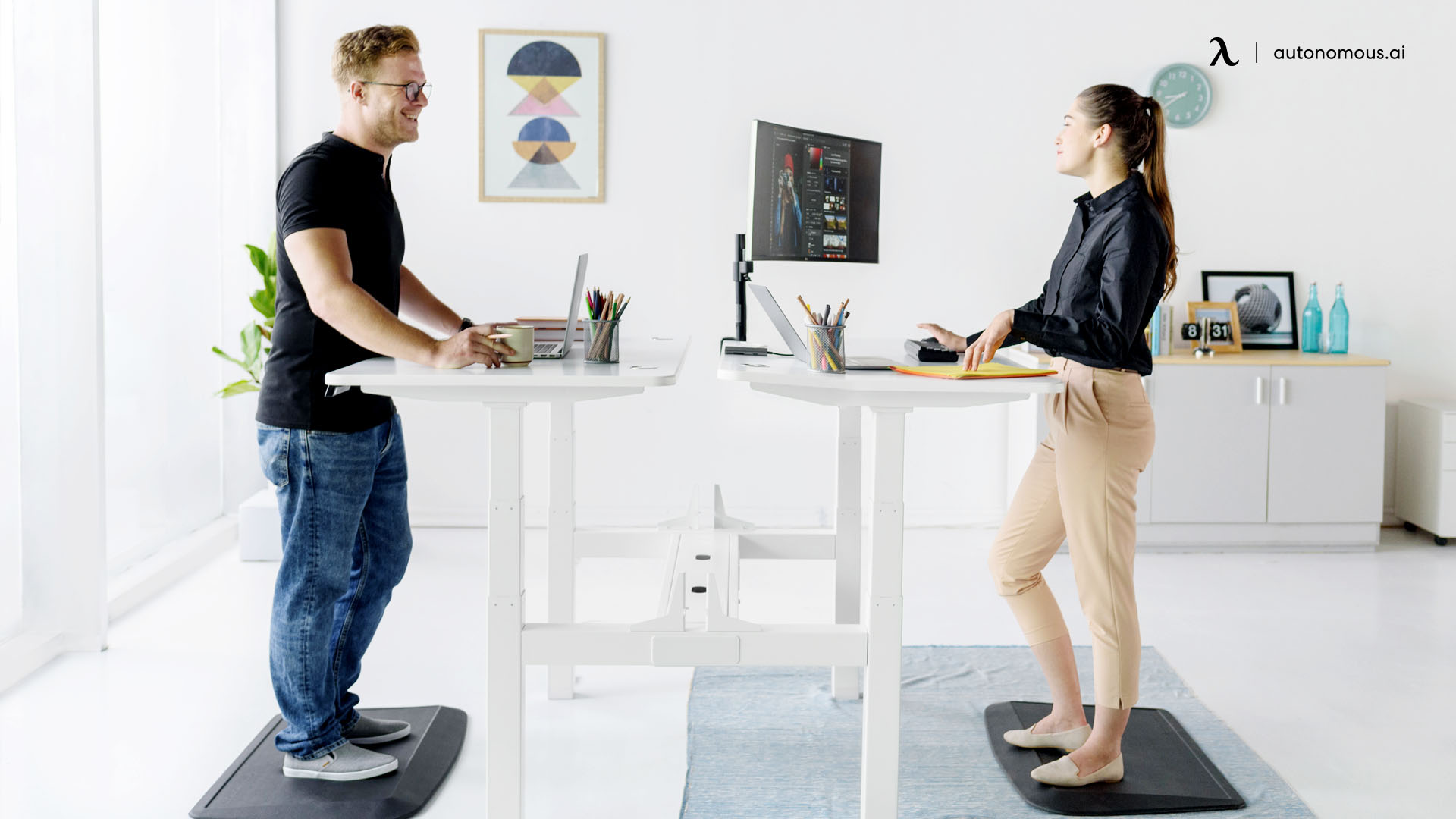
4. Wear The Right Shoes
Footwear matters more than you think. When you're standing for extended periods, shoes with solid arch support and cushioned soles help absorb pressure and minimize discomfort. Even if you work from home, consider treating your standing time the same way you’d prep for a walk: comfortable, supportive shoes are a must.
5. Incorporate Cable Management
Because a standing desk moves up and down, so will your cables. Without a proper system in place, they can snag, get tangled, or even get damaged. A clean setup starts with cable trays mounted under the desk to hold power strips and adapters. Use cable trays, zip ties, or desk cable organizers to keep everything secure and clean.
This not only keeps your workstation looking sharp, it also prevents accidents and improves safety.
6. Consider Extra Ergonomic Accessories
Enhancing your desk with the right accessories can make a noticeable difference in comfort and productivity.
- Keyboard tray: Keeps your wrists in a neutral position while standing.
- Armrest or mouse pad with wrist support: Helps reduce pressure on the wrist during long work hours.
- Standing desk balance board: Adds gentle movement to your standing posture and keeps your core subtly engaged.
- Desk light or task lamp: Keeps your work area well-lit without adding eye strain.
And if you're working from home, check out these home office ideas with standing desk for added inspiration.
7. Don’t Stand All Day
The real benefit of a standing desk comes from the balance it creates, not from standing constantly. If you're wondering how long you should stand at a standing desk, start with 20–30 minutes per hour and adjust based on how your body feels. A good rule of thumb: alternate every 30–60 minutes and aim for a 1:1 or 2:1 standing-to-sitting ratio.
The secret to long-term success isn’t standing all day—it’s building a balanced routine that keeps you moving. Finding that rhythm will help you stay energized and productive without discomfort.
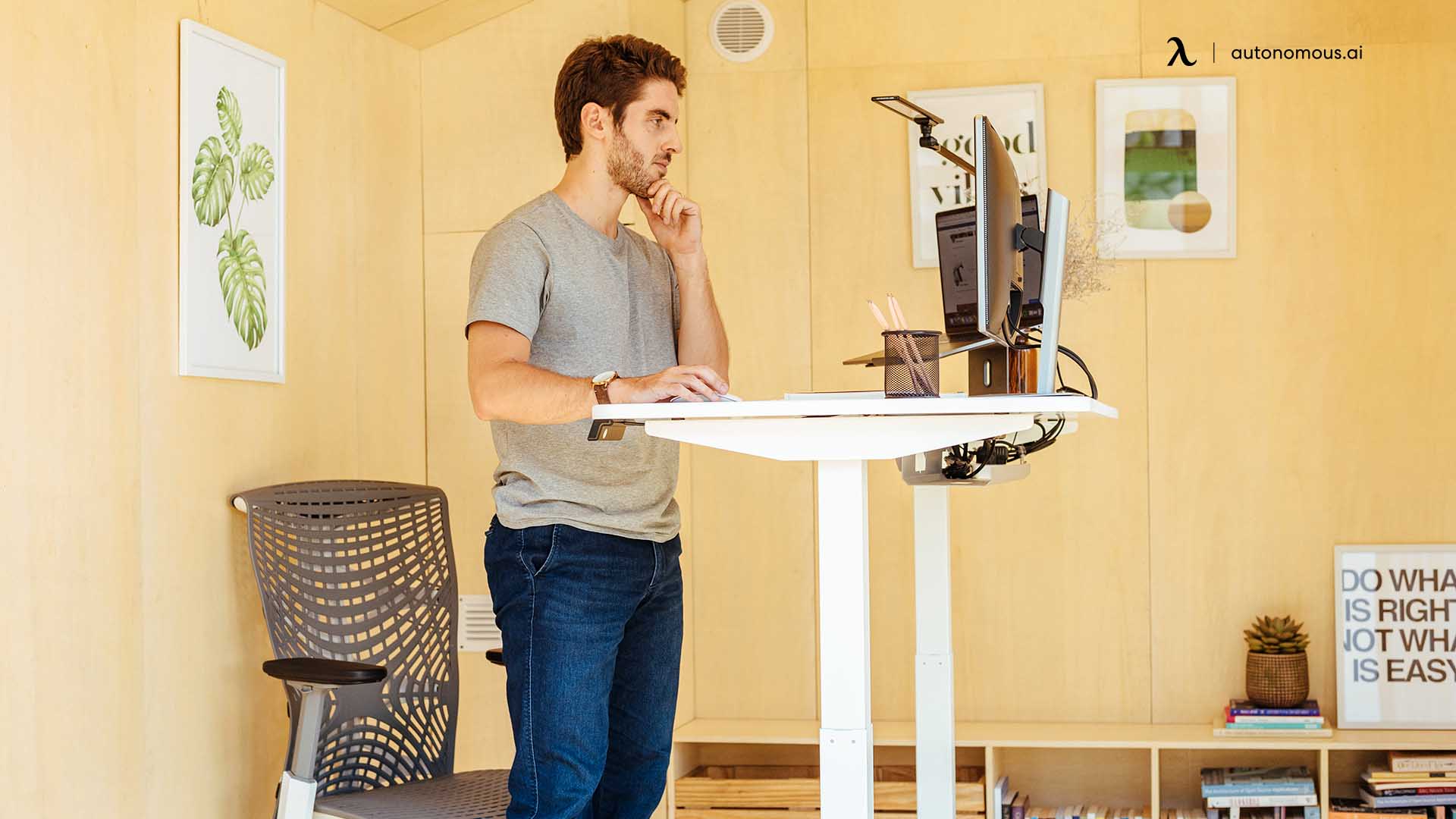
FAQs
1. How long should I stand at a standing desk each day?
Experts recommend standing for about 15 to 30 minutes per hour. You can gradually increase as your body adjusts, but avoid standing for hours on end without breaks.
2. Are standing desks actually better for your health?
Yes—but only when used correctly. Alternating between sitting and standing can help reduce back pain, improve circulation, and boost energy. However, too much standing without support can also cause fatigue or leg discomfort.
3. What are the disadvantages of a standing desk?
Some common disadvantages of standing desk include the higher upfront cost, lack of built-in storage, and the potential for foot, leg, or lower back fatigue—especially if you stand for too long without support.
Fortunately, most of these issues can be managed with proper setup and accessories like anti-fatigue mats, supportive shoes, and an ergonomic sit-stand schedule.
4. Do physical therapists recommend standing desks?
Many physical therapists do recommend standing desks, particularly for patients dealing with back pain, poor posture, or sedentary habits. That said, they typically emphasize moderation and balance—standing desks are most beneficial when used in combination with ergonomic seating, movement breaks, and proper desk height alignment.
5. Do chiropractors recommend standing desks?
Yes, chiropractors often support the use of standing desks as part of a holistic approach to spinal health. Standing can reduce pressure on the lower back and encourage a more upright posture. However, like physical therapists, chiropractors stress the importance of switching positions regularly and maintaining overall body alignment.
Conclusion
When it comes to the pros and cons of a standing desk, the key takeaway is that balance matters. These desks can improve your posture, help reduce back pain, and make your workday more dynamic—but they’re not a cure-all. For a broader comparison to make a smart decision, see our take on standing vs sitting desk setups.
Like any ergonomic solution, they work best when combined with good habits, thoughtful accessories, and regular movement. Whether you're a remote worker, designer, or team leader, understanding the full scope of the pros and cons of a standing desk helps you build a space that’s not just functional, but future-ready. To compare top-rated options, check out our roundup of standing desk brands.
By knowing the real standing desk benefits and risks, you can confidently design a workspace that supports how you work today—and how you want to feel tomorrow.
Spread the word
.svg)







